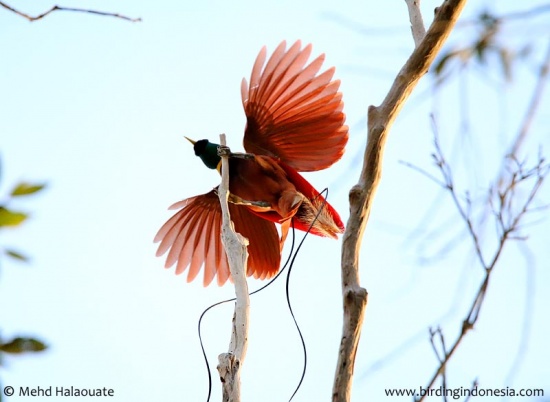- Paradisaea rubra
Identification
Male 33cm (excluding tail wires), female 30cm
Male
- Dark emerald green face, ear-coverts, chin and throat
- Small erectile green cushion-like strucutre on top of head
- Pale orange-yellow rest of head, nape, upper and central mantle and upperwing-coverts
- Washed yellow grading to russet-brown lower central mantle and back
- Reddish-brown upperwing and uppertail
- Central tail feathers grossly elongated, forming two plastic-like, black corkscrew-shaped wires
- Carmine to crimson elongated filamental flank plumes with off-white tips
- Pale orange-yellow upper breast forming a breast-shield
- Dark brown washed maroon rest of underparts
- Dark reddish-brown eye
- Yellow washed pale-green bill
- Bluish-grey to grey-brown legs
Female
- Smaller and without elongated tail-feathers or flank-feathers
- Dark brown face and throat
- Buff-yellow rear-crown, neack and nape, grading into dark brown on upperparts
- Straw-yellow broad bar on upper breast
- Brownish rest of underparts
Juvenile undescribed in wild.
Distribution
Endemic to the West Papuan Islands (Waigeo, Gemien, Saonek, Batanta and presumably also Gam) off northwest New Guinea. Fairly common in suitable habitat. Habitat loss due to logging and mining.
Taxonomy
This is a monotypic species.
May form a superspecies with Lesser Bird-of-Paradise, Raggiana Bird-of-Paradise, Greater Bird-of-Paradise and Goldie's Bird-of-Paradise.
Habitat
Lowland and hill rainforest. Occurs from sea-level up to 600m.
Behaviour
Diet
Diet little known. Feeds on fruits and arthropods.
Breeding
Breeding season probably from September to October. A polygynous species. Up to 10 males form a lek in large trees. The display involves several postures and a dance phase.
The female builds and attends the nest alone. No information about nest. Lays 1 - 2 eggs in captivity.
Movements
Presumably a resident species.
References
- Clements, JF. 2009. The Clements Checklist of Birds of the World. 6th ed., with updates to December 2009. Ithaca: Cornell Univ. Press. ISBN 978-0801445019.
- Del Hoyo, J, A Elliott, and D Christie, eds. 2009. Handbook of the Birds of the World. Volume 14: Bush-shrikes to Old World Sparrows. Barcelona: Lynx Edicions. ISBN 978-8496553507
Recommended Citation
- BirdForum Opus contributors. (2025) Red Bird-of-Paradise. In: BirdForum, the forum for wild birds and birding. Retrieved 30 April 2025 from https://www.birdforum.net/opus/Red_Bird-of-Paradise
External Links
GSearch checked for 2020 platform.1





